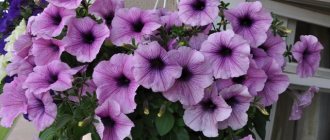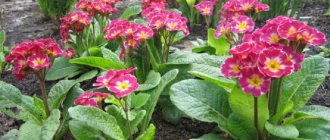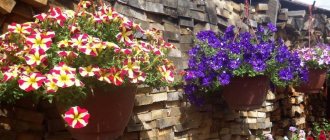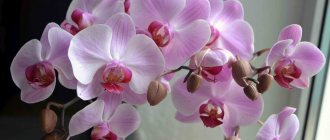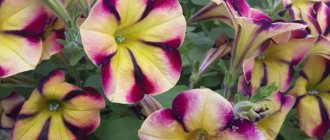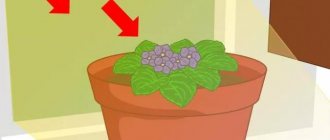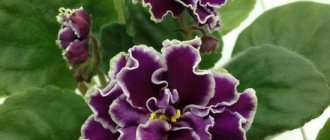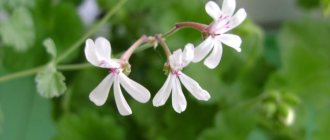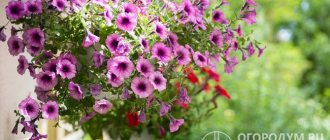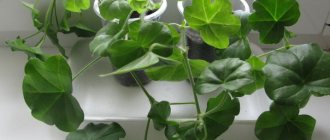- Care instructions
Petunias are incredibly beautiful flowers that are very popular among gardeners. Based on the shape of the plants and the type of shoots, numerous varieties of crops are divided into bushy (or bushy, erect) and hanging (or creeping, ampelous), which are grown in hanging containers or in open ground as ground covers. The differences between cascading petunias and hanging petunias are very conditional, so they are often classified in general as hanging species, separating cascade (or semi-ampeling) into a separate group or category.
Blooming petunia is a bright and original decoration for any garden plot, balcony or veranda
In the article we will talk in detail about the features of popular varieties, and also try to highlight the main differences that are important to consider when caring for plants.
Kinds
Ampelnaya
Ampelous petunia has a number of properties characteristic only of it. It is almost impossible to confuse it with most other types of petunias. The length of its shoots can reach more than a meter, but the shoots neatly fall down and do not stick out in all directions. Because of these properties, it is most often grown in hanging pots - in them it looks most elegant and luxurious. Read about what other varieties of petunias can be grown in flower pots here.
Petunia has very delicate and soft leaves. Older leaves, which are closer to the root, are usually larger in size than young leaves on the shoots.
Flowers of various shades are very reminiscent of bells and are located along the entire length of the shoot. In some varieties the flowers are larger and reach a diameter of 10 cm, while in others only from three to five.
Petunia is a unique plant. On one shoot there may be buds not only of different sizes, but also of different colors. There are colors from snow-white to dark purple.
Cascade
Cascade petunia is essentially a variety of ampelous petunia, which has its own unique characteristics. First of all, it is distinguished by thicker shoots - up to one and a half meters in length. Until they reach a certain length, they grow upward and then hang down.
The shoots are quite strong and do not break in the wind. If this plant is planted in a hanging pot, it will look very much like an octopus. Its flowers reach 5-8 cm in diameter, all of the same size. Their shades may vary, but not very much.
Ampel variety
General description of the appearance of ampelous petunia:
- bush height from 30 cm to 1 m;
- stems - long, thin, drooping or spreading along a horizontal surface;
- foliage - medium size, pale green;
- flowers - located in the leaf axils, have a diameter of 3-10 cm;
- color - depending on the variety, it can be anything, white, red, yellow, purple.
The calling card of many varieties is the double color of the petals, which have a more saturated shade on the inside.
The most famous varieties:
- Snow Queen - snow-white petals;
- Katerina - yellow flowers with a hint of red;
- Corduroy - petals are characterized by a velvety surface, color - any;
- Mashenka - the main color is bright pink, the middle is yellow;
- Opera - main shades - red, white, pink.
The ampelous variety has strong immunity and resistance to diseases.
The ampelous variety is considered one of the most colorful, as it is represented in all sorts of colors.
Photo
Check out the photos of both types of flowers to understand the differences between them.
Ampelnaya:
Cascade:
Cascade petunia
The cascade variety has approximately the same purpose - to decorate balconies and all kinds of vertical surfaces. Cascade petunia also produces long shoots, not inferior to, and even superior to, ampelous petunia.
Among the types of cascading petunia you can choose Easy Wave, Dubble Cascade, Marco Polo, Gioconda, Rosie Velvet and others.
Still, some differences between the two types exist.
How are these types different?
These two plants are surprisingly similar, because not only do they belong to the same species, but they are also close relatives. Still, there are differences between them. Their shoots are of unequal length and thickness. In ampelous petunia they are drier and brittle.
Cascade petunia has an amazing climbing ability and can be used to decorate hedges. Differences are also visible in the size of the buds. To make the comparison more clear, the table is filled with basic data about these plants.
comparison table
| Description | Cascade | Ampelnaya |
| Shoot size | Up to 1.5 m, grows quickly, can wrap around a support. | Up to 1.2 m. |
| Size and color of flowers | Large flowers of the same size, similar shades. | Flowers up to 8-10 cm in size, of different shades, often two-color. |
| Subtleties of cultivation | Cuttings and seeds | |
| Required soil | Fertile, ideally black soil | |
| Feeding, watering | Demanding on fertilizing and watering | |
| Landing places | Flower beds, pots, free areas of the garden, flowerpots, tubs | Wickers, tubs, flowerpots. |
| Bloom | From mid-June continuously until the start of frost. | |
| Do I need to pinch? | Yes, so that the flower grows faster and more accurately. | No |
| Features of growth | First they stretch upward, then spread out to the sides | Immediately pulled down |
Technology and methods of sowing seeds for seedlings
There are several ways to sow tiny seeds:
- in a mini-greenhouse;
- into hydrogel;
- in the snow;
- into peat tablets.
The first method uses a mini-greenhouse to grow seedlings. It can be purchased at a garden center or made from a small container with a transparent lid. It is easier to maintain an optimal microclimate inside the structure.
Attention! Be sure to make drainage holes to drain excess liquid.
As a substrate, gardeners recommend using a mixture of equal proportions of peat, sand, steamed garden soil and humus. The resulting soil will be light, nutritious, structured and have an optimal pH level. The container is filled with soil mixture, watered and set aside for 24 hours. Then, the seeds are laid out on the surface of the substrate.
The most convenient way to do this is with a toothpick or mix the seed with sand and “salt” the soil. When using coated material, you need to carefully break the integrity of the nutritional membrane with a toothpick. The seeds will need light to germinate, so digging is not required. Just lightly press the soil and spray it with a spray bottle. Cover the greenhouse with a lid and place it in a warm place with a temperature of at least 22⁰C.
To clearly see the unsown areas of the container, gardeners sow seeds in the snow. To do this, the container is filled two-thirds with soil, and the remaining space is filled with compacted snow. Melt water will carry away the grains. Distribute them evenly over the surface. It was noted that snow water has a positive effect on the further development of seedlings.
Know! Some gardeners sow seeds in hydrogel. For best results, it is recommended to saturate the substance with a weak solution of fertilizers or mix it with soil. The technology is similar to sowing in a container.
The convenience of peat tablets for growing seedlings has been appreciated by many summer residents. The peat in the washers has already undergone special treatment, so the seedlings will not be afraid of fungal diseases. Small cylinders allow you to carefully transplant seedlings without damaging the root system. The sowing technology will remain the same - 1-2 seeds are placed in the center of the prepared tablet using a toothpick. Cultivation is carried out in a mini-greenhouse. The tablets should be pre-watered with warm water until they stop increasing in height.
The main problem when using peat tablets is the rapid drying out of the substrate and the appearance of mold from waterlogging. It is removed with a cotton swab, and then the surface is treated with phytosporin.
Seedling care
7-10 days after sowing, the surface of the soil will be covered with tiny thin sprouts. At first, they are ventilated daily and, if necessary, the soil is sprayed with a sprayer. Be sure to remove excess condensation. High humidity often provokes the development of blackleg. It is almost impossible to save seedlings from this scourge.
Further care for petunia:
- Keep at a temperature of 20-23⁰C.
- If necessary, additional lighting is used up to 12-14 hours a day.
- The shelter from the greenhouse is gradually removed, after which once every 2 weeks the temperature background is reduced by several degrees for hardening.
- The irrigation regime depends on the air humidity in the apartment. If the house is hot, spray the seedlings twice a day; if humidity is high, reduce watering to 2-3 times a week.
- Picking is carried out at the stage of development of the fourth leaf. Use the transfer method, trying to maintain the integrity of the earthen ball around the roots.
- Choose spacious pots for picking or repeat the event in a month.
- After 10-14 days from picking, start feeding the seedlings. Alternate root and foliar feeding with a complete mineral complex. The frequency of application is 2 times a month.
- Planting in a permanent place or in an outdoor container is carried out after the return frosts have subsided in your region.
- Petunia is planted in a well-lit place with fertilized loamy soil. Follow the recommended planting pattern.
Remember! Nitrogen fertilizers provoke active growth, so they are used twice during cultivation - after picking and after transplanting. In the future, give preference to the potassium-phosphorus complex.
Difference in care
Since ampelous and cascading petunias are not very different from each other in origin, there will not be too many individual characteristics when caring for each of them, but you still need to take into account some nuances in order to get the most beautiful and healthy plants.
For example, it is better to plant ampelous petunia in open ground after consistently warm days have established itself - any frost can be critical for it. It is believed that the best time to transplant ampelous petunia to its permanent place is the beginning or even mid-June.
You can also use garden boxes or flowerpots for growing - petunia will look beautiful anywhere. But you don’t need to plant it next to other flowers. Petunias grow very quickly and will simply choke out all the other plants in the flowerbed. A much better option would be to allocate a separate corner for these flowers - then soon it will be covered with a luxurious fragrant carpet of buds.
Ampelous petunia is very demanding on fertilizers and watering . You need to be especially careful at the beginning of flowering, when the buds are just blooming - at such moments the flower is extremely sensitive to the amount of moisture and the quality of fertilizing. You should not allow water to stagnate near the roots of ampelous petunia - they very quickly begin to rot and young shoots die.
If you choose the right fertilizing and watering frequency, petunia will delight you with its magnificent flowers from the beginning of June until the first frost.
Cascade petunia has its own characteristics, although in essence it is one of the subspecies of the canopy petunia. So, for example, for the most comfortable growth, it will need a separate small clearing - cascading petunia spreads its lashes, forming a natural flowerbed with a diameter of up to one and a half to two meters.
Petunia also grows well by clinging to support - for example, a pole or a fence. However, in this case, it will have to be specially directed in the right direction so that the flowers do not begin to creep on each other and hang down.
When planting cascading petunias, you should always ensure that the distance between seedlings is at least 50 cm . Otherwise, the shoots will simply choke each other; they will not have enough space to grow and show all their beauty.
If you plan to grow cascade petunia in pots or tubs, then you need to make sure that their volume is large enough - at least 5 liters of soil per shoot. If you want to plant 2 or 3 plants in one container at once, then it is better to take a pot larger than 15 liters.
Also, in order to get a cascading petunia of a beautiful shape and achieve the most abundant flowering, it must be regularly plucked , which in no case should be done when working with hanging varieties of petunia.
Reviews from flower growers
Olga, 35 years old, Ekaterinburg
As amateur gardeners, we always want to try something new. So I stubbornly did not want to plant classic petunias in my garden plot and was chasing expensive hybrids. But, as practice has shown, growing them is not so easy. For example, “Petunia F1 Hot Summer” gave only 50% germination, and out of 20 seeds of the fringed “Sleeping Beauty” only 3 germinated, and even then the sprouts were subsequently crushed in the flower garden. My best purchase was a mixture of hybrid petunia seeds. They are very cheap, there are 100 g of seeds in a pack (well, a lot!), and the germination rate is almost 100%. Of course, the flowers are not so bright, but they look great in large areas!
Valentina, 53 years old, Krasnoyarsk
Last year, seedlings of ampelous petunia Cascadias Rim Magenta No. 115 accidentally fell into my hands. I had never been involved in growing flowers before, but here I had to - I didn’t want the gift to go to waste. I read that such plants require spacious pots. Therefore, the first thing I did was transplant it into a large pot filled with 10-12 liters of a mixture of humus, sand and soil (added a little more perlite). I didn’t expect the plant to respond so quickly. After just 2 weeks it turned into a rather fluffy bush with a large number of leaves, under which the soil was no longer visible. There are an incredible number of flowers, they are cherry-purple, velvety, with a pale lemon border. The aroma of the flower is delicate and barely perceptible. The plant is extremely decorative, forms a dense spherical bush. It tolerates rain and wind easily. It loves watering, but drainage must be provided and should not be over-watered. Due to the abundant flowering, it requires regular feeding. I used complex fertilizers. It turned out that propagating this petunia is very simple. All you need is to break off a young shoot 10-12 cm high and place it in water with Kornevin for an hour, and then plant it in a glass with loose nutritious soil.
Inga, 40 years old, Kaluga region
Cascade petunias Marco Polo really do well without pinching, as agro specialists write on seed packets. For me, they sprouted well and began to bush immediately on their own.
How to choose?
The huge variety of varieties and types of petunias can make an inexperienced gardener seriously confused. Indeed, it is not immediately clear whether ampelous or cascading petunias are suitable for decorating a terrace, summer cottage or balcony. But it's actually quite simple. You just have to pay attention to the size of the area that you want to enliven with these lovely flowers.
Ampelous petunia will look great in large garden areas , but may look a little tacky on a tiny terrace.
For decorating small spaces, a cascading petunia climbing along a support, which does not take up much space, is more suitable. But if the size allows, you can turn around and combine both types of flowers, creating a delightful flower arrangement.
Other varieties and hybrids of petunias are no less attractive. Read on our portal about low-growing, dwarf and vegetative species.
Petunias are rightfully one of the best flowers for decorating your home and garden. They will organically fit into almost any space, and even the most picky gardener will definitely find the variety that suits his heart. But in any case, no matter what petunias you choose, these flowers will delight your eye with their unpretentiousness and exquisite beauty for a very long time.
Features of the flower
Why the crop is attractive to gardeners:
- a rich palette for creating landscape design, decorating flower beds and flowerpots;
- unpretentiousness in cultivation;
- compatibility with any crops on the site.
These representatives of the flora are suitable for growing in gardens and balconies
There are three types of petunia:
- ampelous;
- bush;
- cascading.
You can identify a bush variety by its appearance; the shoots are directed upwards or to the sides. However, the differences between ampelous and cascading petunias are less obvious to a novice gardener.
Growing petunia from cuttings
Petunias can be propagated vegetatively by using plants that have overwintered indoors. Shoots are broken out from them, rooted in water and planted in separate pots.
This is done in early spring, and in winter they care for the bush, maintaining the required temperature, fertilizing with phosphorus and potassium, and daily irrigating with water at room temperature.
Petunias planted in a permanent place throughout the season, in addition to watering and loosening, require feeding with complex mineral fertilizers. To form a bush of the desired shape, pruning is performed. Be sure to remove faded flowers, this will not only improve the appearance of the bush, but also stimulate the formation of new buds.
Preparing the soil
Any high-quality commercial soil for seedlings or universal soil is suitable for planting petunias. In this regard, the plant, fortunately, is not overly capricious - the main thing is that the soil is loose, nutritious and can sufficiently retain moisture. The soil reaction should be neutral or slightly acidic.
If possible, the soil should be steamed (or calcined in the oven) for 40-60 minutes to prevent the seedlings from developing blacklegs.
Good soil is the key to success
Before pouring it into the container where planting will take place, all large foreign elements - roots, stones, lumps, etc. - are first removed from the soil. You can also sift it so that it has a uniform and loose structure. If possible, it is worth adding a little vermiculite.
It is also possible to independently prepare the soil mixture, although from the point of view of the ratio of results and labor costs, this option is not the most optimal. Nowadays, it is much easier to purchase ready-made soil for planting, especially since you only need a little of it at first. In general, we present the composition and proportions for the mixture with your own hands, rather just in case: 1 part humus, 1 part leaf soil, 1 part turf soil, 1 part lowland peat, ½ part sand.
